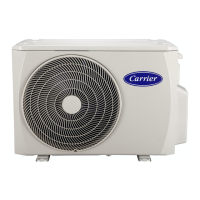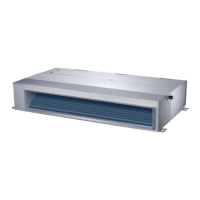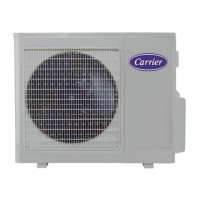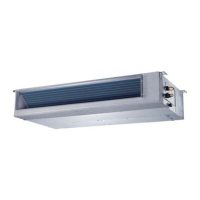
Do you have a question about the Carrier 38QUS014DS2 series and is the answer not in the manual?
| Heating Seasonal Performance Factor (HSPF) | 10 |
|---|---|
| Refrigerant | R-410A |
| Cooling Capacity | 14, 000 BTU |
| Power Supply | 208-230V, 1 Phase, 60 Hz |
| Outdoor Unit Dimensions (H x W x D) | 21.7 x 31.5 x 12.6 inches |
Crucial safety guidelines for handling AC equipment, electrical work, and refrigerant.
Lists and describes all included installation parts and optional accessories for the AC system.
Outlines the sequential steps involved in the air conditioning unit installation process.
Visual representation of system layout, including indoor/outdoor unit placement and pipe routing.
Detailed instructions for selecting the location and mounting the outdoor AC unit.
Steps for installing the drain joint at the bottom of the outdoor unit for condensate removal.
Guidance on drilling wall holes for refrigerant piping and signal cables, including precautions.
Information on connecting 24K indoor units to specific system types (A/B).
Essential safety measures and regulations for handling refrigerant piping connections.
Critical safety warnings and guidelines for electrical wiring installation.
Instructions for correctly wiring the outdoor unit, including cable selection.
Diagrams illustrating electrical connections for various system configurations.
Safety guidelines for performing air evacuation of the refrigeration system.
Step-by-step guide on using manifold gauges and vacuum pumps for system evacuation.
Guidance on adding refrigerant based on pipe length and system configuration.
Procedures for performing electrical safety checks and gas leak detection.
Pre-test checks to ensure the system is correctly installed and ready for operation.
Steps for performing a functional test run of the indoor and outdoor units.
Explanation of the automatic system for correcting wiring and piping errors.
Instructions on how to enable and use the automatic wiring/piping correction feature.
Safety checks required for the work area before servicing systems with flammable refrigerants.
Guidelines for performing servicing work in a controlled manner to minimize fire hazards.
Instructions for informing staff and securing the work area for safe servicing operations.
Procedures for checking the work area for flammable refrigerant presence using detectors.
Requirement for having appropriate fire extinguishing equipment readily available.
Strict prohibition of ignition sources in areas where flammable refrigerants are present.
Ensuring adequate ventilation of the work area during servicing operations.
Checks to ensure refrigeration system components are fit for purpose and correctly specified.
Initial safety checks and component inspections for electrical devices during repair.
Procedures for servicing sealed components, including electrical isolation and leak detection.
Guidelines for working on intrinsically safe components, ensuring safety in flammable atmospheres.
Checks for cabling to ensure it is free from wear, corrosion, vibration, and other adverse effects.
Prohibits use of ignition sources when searching for or detecting refrigerant leaks.
Acceptable methods for detecting leaks in systems containing flammable refrigerants.
Procedures for removing and evacuating refrigerant from the system, emphasizing safety.
Requirements for refrigerant charging procedures, including contamination prevention and pressure testing.
Procedures for safely decommissioning the equipment and recovering refrigerants.
Requirements for labelling equipment that has been decommissioned and emptied of refrigerant.
Best practices for safely removing and transferring refrigerants during servicing or decommissioning.
Guidelines for transporting, marking, and storing units containing flammable refrigerants.












